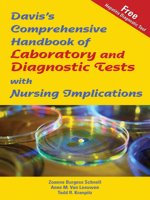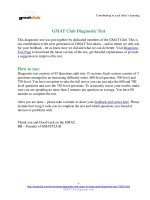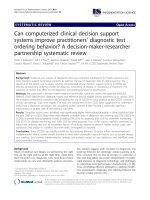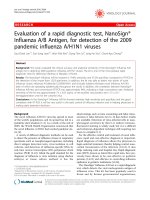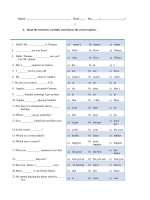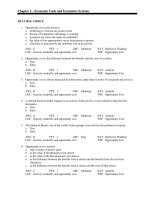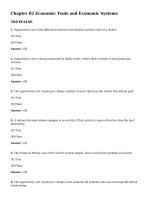Diagnostic test macro
Bạn đang xem bản rút gọn của tài liệu. Xem và tải ngay bản đầy đủ của tài liệu tại đây (85.9 KB, 3 trang )
<span class="text_page_counter">Trang 1</span><div class="page_container" data-page="1">
<b>UNIVERSITY OF ECONOMICS AND LAW FACULTY OF ECONOMICS</b>
Socilalist Republic of Vietnam Independence-Freedom – Happiness
<b>DIAGNOSTIC TEST OF MACROECONOMICS</b>
For Class Code: 232EC94 Time Duration: 20 minutes
</div><span class="text_page_counter">Trang 2</span><div class="page_container" data-page="2">1. Which of the following statistics is usually regarded as the best single measure of a society’s economic well-being?
gross domestic product
the trade deficit
2. If a nation’s GDP rises, then it must be the case that the nation’s
may rise or fall.
d. saving rises, but income may rise or fall 3. For the purpose of <i>calculating GDP, investment is</i>
spending on
a. stocks, bonds, and other financial assets. b. real estate and financial assets.
c. new capital equipment, inventories, and structures, including new housing.
d. capital equipment, inventories, and structures, excluding household purchases of new housing. 4. Transfer payments are
a. included in GDP because they represent income to individuals.
b. included in GDP because the income eventually will be spent on consumption.
c. not included in GDP because they are not payments for currently produced goods or services. d. not included in GDP because taxes will have to be raised to pay for them.
5. The CPI is a measure of the overall cost of
a. inputs purchased by a typical producer. c. goods and services produced in the economy. b. goods and services bought by a typical consumer. d. stocks on the New York Stock Exchange. 6. Ralph puts money in the bank and earns a 5 percent nominal interest rate. Then, if the inflation rate is 3 percent,
a. Ralph will have 3 percent more money, which will purchase 2 percent more goods. b. Ralph will have 3 percent more money, which will purchase 8 percent more goods. c. Ralph will have 5 percent more money, which will purchase 2 percent more goods. d. Ralph will have 5 percent more money, which will purchase 8 percent more goods
7. Ted is working part time. Alice is on temporary layoff. Who is counted as employed by the BLS?
b. only Alice d. neither Ted nor Alice 8. Who would be included in the labor force?
a. Dakota, an unpaid homemaker not looking for other work b. Brad, a full-time student not looking for work
c. Maggie, who does not have a job, but is looking for work d. None of the above is included in the labor force.
9. Liquidity refers to
a. the ease with which an asset is converted to the medium of exchange. b. a measurement of the intrinsic value of commodity money.
c. the suitability of an asset to serve as a store of value. d. how many time a dollar circulates in a given year.
10. A country sells more to foreign countries than it buys from them. It has
a. a trade surplus and positive net exports. c. a trade deficit and positive net exports. b.a trade surplus and negative net exports. d. a trade deficit and negative net exports
11. Other things the same, if the exchange rate changes from 41 Thai bhat per dollar to 35 Thai bhat per dollar, the dollar has
a. appreciated and so buys more Thai goods. c. depreciated and so buys more Thai goods. b. appreciated and so buys fewer Thai goods. d. depreciated and so buys fewer Thai goods 12. When a country's central bank increases the money supply, its
a. price level rises and its currency appreciates relative to other currencies in the world.
</div><span class="text_page_counter">Trang 3</span><div class="page_container" data-page="3">b. price level rises and its currency depreciates relative to other currencies in the world. c. price level falls and its currency appreciates relative to other currencies in the world. d. price level falls and its currency depreciates relative to other currencies in the world. 13. The model of aggregate demand and aggregate supply explains the relationship between a. the price and quantity of a particular good. c. wages and employment b. unemployment and output. d. real GDP and the price level. 41.
<i>14. Economists use the term “money” to refer to</i>
a. all wealth.
b. all assets, including real assets and financial assets. c. all financial assets, but not real assets.
d. those types of wealth that are regularly accepted by sellers in exchange for goods and services. 15. During a recession the economy experiences
a. rising employment and income. c. rising income and falling employment. b. rising employment and falling income. d. falling employment and income
16. Both Tom and Jerry work eight hours a day. Tom can produce six baskets of goods per hour while Jerry can produce four baskets of the same goods per hour. It follows that Tom's
a. productivity is greater than Jerry's. c. standard of living is higher than Jerry's b. output is greater than Jerry's. d. All of the above are correct
17. The inputs used to produce goods and services are also called
a. productivity indicators. c. production functions b. capitalization producers. d. factors of production 18. Which of the following is an example of a renewable resources?
a. fish b. iron c. petroleum d. All of the above are correct
<b>---THE </b>
</div>